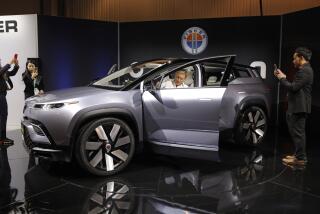Fisher Leaves Motorola in Good Shape : Management: His replacement will take over a company that is a leader in fast-growing wireless communications.
- Share via
NEW YORK — For Motorola Inc., the news that its chairman was quitting to run Eastman Kodak Co. was stunning and unwelcome. But it would be even more stunning if Fisher’s departure caused any serious problems at the Chicago-area company.
Industry executives said Thursday that Motorola’s remarkable success in recent years is less a reflection of Chairman George M.C. Fisher’s brilliance than of broad-based managerial competence and a deep commitment to obvious but important principles such as superior product quality, rigorous employee education and entrepreneurial initiative.
Investors apparently agree. Motorola was down just $1.125 to close at $104.50 in New York Stock Exchange trading on Thursday, on a day in which semiconductor stocks fell generally.
Fisher, appearing at a New York news conference Thursday, acknowledged that there was “shock and disappointment” over his departure, but added, “I would not have left if I didn’t think we had built a world-class team and that the company could do just as well without me.”
Certainly Motorola thrived during Fisher’s tenure. From 1988, when he became chief executive, to 1992, revenue and cash flow (net income plus depreciation) grew about 60% each, with sales last year passing $13.3 billion. This year is expected to be particularly strong, but instead of resting on its laurels, the company spends heavily on research and development. It plowed $1.3 billion into R&D; last year alone.
The very success of Motorola and the concomitant lack of grand challenges there may have contributed to Fisher’s decision to leave. Kodak, with its premier brand name and broad expertise in imaging, has an opportunity to play a major role in the multimedia revolution, Fisher said.
But he declined to discuss details of another likely motivator, his compensation package, saying only that it was incentive-oriented and that “if Kodak does well, I will do extremely well.” And his first order of business will be a potentially disagreeable one: “Make sure our financial house is in order.”
At Motorola, the first order of business will be to choose Fisher’s successor, but the company is in a good position to make the transition with minimal disruption. It already had a three-person office of the chief executive, and one of its members, Chief Operating Officer Gary Tooker, is now serving as interim chief executive.
Much attention is now focused on the third member of the office: senior executive vice president Christopher Galvin, grandson of Motorola founder Paul Galvin and son of Fisher’s predecessor, Robert Galvin. While Tooker is known as a tough, operations-oriented manager, Chris Galvin is considered by some to have more flair, and he is popular within the company.
“A lot of people would like to see Chris in there,” said one Motorola executive, adding that Galvin has the “people values” that are central to the company’s culture.
A Motorola spokesman said the board will meet today to begin discussion of the succession issue. Neither Galvin nor Tooker was available for comment.
Whoever takes over the top spot will have plenty of support. “They really have a lot of backup management,” said Jerry Sanders, chairman of rival chip maker Advanced Micro Devices. “I don’t think there’s a company in the industry that has as deep a bench as Motorola.”
And the new CEO will inherit a company with a powerful position in one of the world’s fastest-growing industries: wireless communications. It is a world leader in pagers, cellular telephones and two-way radio systems, and is engaged in a range of ambitious communications service ventures, including the $3.7-billion Iridium project to build a global satellite-based phone system.
Motorola’s other main business, computer chips, is no also-ran either. Richard Shaffer, principle of the New York consulting firm Technologic Partners, noted that Motorola absorbed what could have been a devastating blow when IBM chose a rival chip from Intel Corp.
That decision has propelled Intel to the top of the worldwide chip league and ended Motorola’s reign as the leading supplier of microprocessors. But Motorola has remained a strong No. 2 in microprocessors, and stands to regain more ground through the PowerPC joint venture with IBM and Apple.
In the meantime, it has built a strong business supplying microprocessors for use in products ranging from cars to printers, and also has a range of specialty chips for communications products, including its own. It was chip design expertise, in fact, that enabled Motorola in the mid-1980s to develop a cellular telephone far smaller and lighter than anything the Japanese had to offer.
And the company also proved itself politically savvy, lobbying to gain access to the Japanese market for pagers and other wireless equipment--a success that Fisher hopes to duplicate at Kodak. More than half of Motorola’s sales now come from overseas.
All of these triumphs have their roots in a corporate culture that is simultaneously nurturing and competitive. James F. Moore, a consultant with Geopartners Research in Cambridge who has done work for Motorola, said the company “has the feeling of a very sophisticated family business.”
But it’s a meritocratic family business--Chris Galvin works harder than anyone, according to one executive. It is dominated by engineers, and has systematic processes in place to help it anticipate how technologies will change and what opportunities they will create.
While execution--good design and high-quality manufacturing--is clearly crucial to the company’s success, its ability to anticipate the direction of the market might be its most extraordinary trait. And that’s a talent that must be present at the top. Paul Galvin, Robert Galvin and George Fisher had that ability. The new CEO will need it too.






